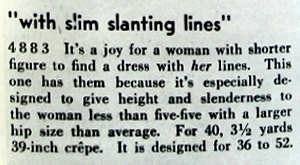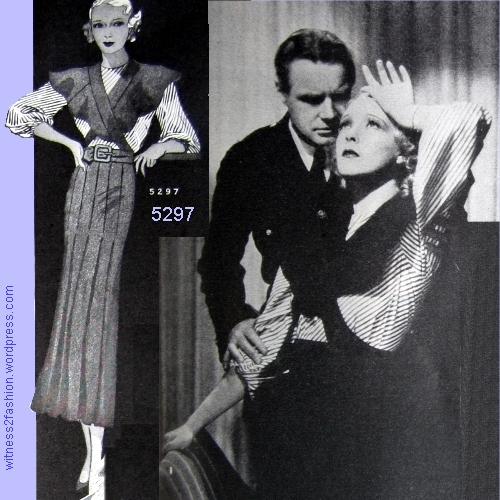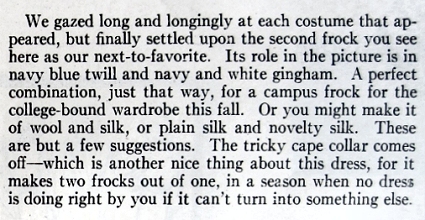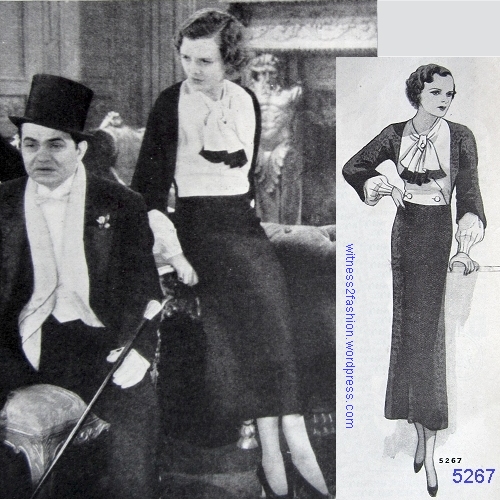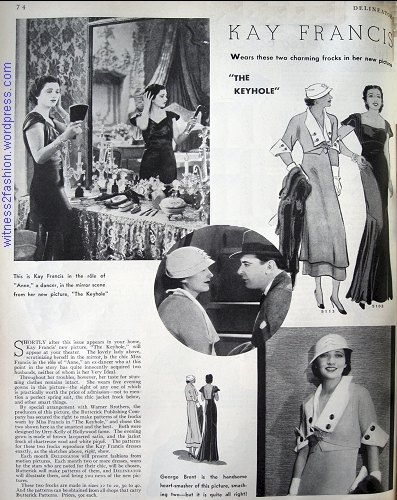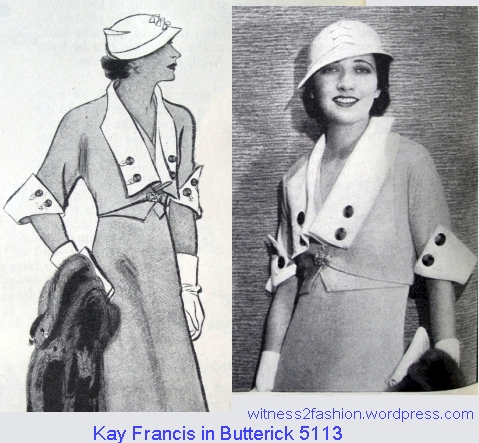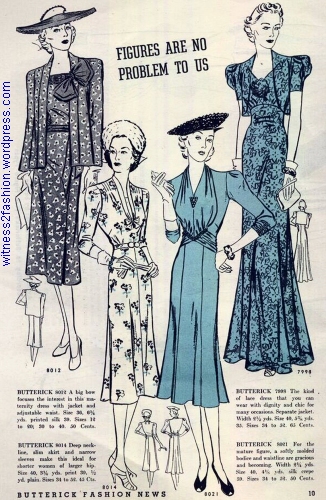
Butterick suggests a “Clubwoman’s Wardrobe for $30.00.” Delineator, Feb. 1933. “The colors are, from left to right, black, green, gray and black.”
“Clubwomen” implies enough leisure to participate in community fundraisers, bridge parties, etc. The Delineator‘s target reader was middle-class (Butterick patterns were more expensive than “dime-store” patterns.) But this was 1933, and many formerly “comfortable” people were struggling to keep their (1929) pre-crash position in the economy. This article assured “clubwomen” that they could afford to dress well, making four outfits for $30. As we might expect, “clubwomen” were often women whose children were grown, women of a “certain age” and, in some cases, a less than ideal figure.
Clubwoman’s Figure
“I have what is known as the ‘clubwoman’s figure’ and I suffer from those I-can’t-find-anything-to-fit-me blues…. I am so tired of those oldish frocks that shopkeepers seem to think anyone weighing over a hundred and twenty should wear.”
Delineator suggested a four pattern wardrobe to solve these problems and gave the cost for materials to make each of them. Not surprisingly, the coat and the evening ensemble were the most expensive. However, a coat might be expected to last for two years.
Butterick 4902 coat pattern for 1933

Butterick coat pattern 4902, from Delineator, Feb. 1933. Estimated cost of materials is $9.91. Sizes up to 44 inch bust.
The coat pattern was available in sizes 12 to 20, 30 to 44 inch bust measure. This was a normal range of women’s sizes for Butterick in 1933, equivalent to modern sizes 6 through 22.
Butterick dress pattern 4840 from 1933

Butterick No. 4840 for “clubwomen.” It could be made for $ 5.20 and came in sizes up to 44 inch bust measure.
The solid color on the wrap bodice isn’t allowed for on the pattern — which I have not been able to locate at the Vintage Pattern Wikia or at CoPA. The largest size on this pattern was for a 44 inch bust, which usually meant 47.5 inch hips.
Butterick dress pattern 4790 from 1933

Butterick No. 4790, a “clubwoman’s dress” from Feb. 1933. It was available in large sizes and could be made for $5.26, including materials, buttons and pattern.
Even a clubwoman with a 52 inch bust (a modern size 30W) could use this pattern.
Butterick evening ensemble 4904 from 1933

Butterick evening grown and jacket pattern. No. 4904 from 1933. Suggested for mature women, its materials cost $9.63 (or $10.88.)
This evening gown and matching jacket were suggested for “clubwomen” in sizes up to a 48″ bust measurement, size 26W in 2016.

Description of Butterick pattern 4904. If you line the lace yoke with flesh chiffon as recommended, the materials and pattern would cost $10.88.
Although this outfit looks like velvet in the illustration, the budget suggests “heavy sheer black crepe” and black lace. “With the jacket, this is correct for any formal afternoon occasion. Without the jacket, it is suitable for evening. So that it could be used for both purposes, we made it rather long — eight inches from the floor. For best effect, use lace that is not too hole-y and line the lace with flesh chiffon…. Those two bright spots at the neckline are double rhinestone clips. And when you want to look especially ravishing, give yourself a big bunch of purple violets and pin them, with their spread-out green leaves, just below that high point in the skirt.” [The skirt goes all the way up to the sternum on this pattern.]
This wardrobe, according to editor Marian Corey, could be worn six months of the year, if cleaned regularly.
“It has got the right dress for every occasion, from shopping in town to traveling in Europe, or presiding over a club meeting, or attending a wedding. And it is inexpensive — costing, if one makes it oneself, just $30.00.” [In the 1930’s, many female college graduates were getting by on $18 per week.]
The same issue of Delineator had two more pages dedicated to hard-to-fit women. If coat No. 4902 wasn’t big enough, this coat and dress for “The Shorter Figure” (short in relation to its circumference) were featured on page 77.
Dress 4883 is “especially designed to give height and slenderness to the woman less than five-five with a larger hip size than average.” [That’s a surprise; apparently Butterick expected the average woman to be taller than 5′ 5″] Diagonal (or “surplice“) lines were often suggested as slenderizing. The cleverly cut back of this “height-giving” coat does create the illusion that the waist is much smaller than it really is. “Created with shorter women in mind.” These are not yet called “half-sized” patterns, however.
On page 76 there were two more patterns designed for the “clubwoman’s figure” — here called “dresses with slender lines.”
You can see that the print dress does look slightly less short-waisted than its neighbor. [But not very flattering to the hips!]
And, in the same issue, women who were not young and slim could find an ad for the Lane Bryant Stout Women’s catalog:
The prices shown on the cover ($5.95 to $8.95) are not too far off Butterick’s make-it-yourself estimates. The dress at right has a skirt extending in a point up to the sternum, like the evening pattern suggested for clubwomen; its sleeves are also very similar to the “clubwomen’s” patterns. The illustration style, however, is a bit more realistic.






